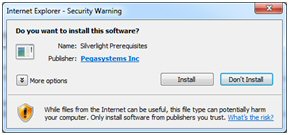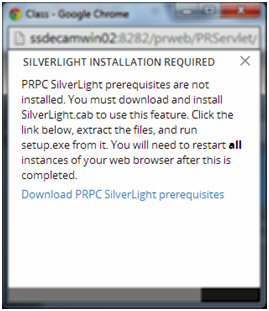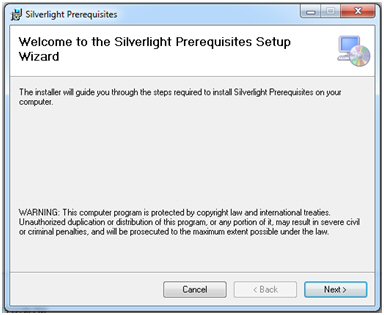Word merge support with Microsoft Silverlight plug-in
Valid from Pega Version 7.1.3
PRPC features that integrate with the Word merge capability are now cross-browser. ActiveX controls (which are only compatible with IE) have been replaced with Microsoft Silverlight. This plug-in must be downloaded separately from Microsoft, as it is not shipped with PRPC.
Some common PRPC features affected by this change include the Application Document Wizard, App Profile, Specifications Landing Page, Specification form, and Case Type Landing Page.
Prior to using these features, Users of PRPC 7.1.3 need to set up their client system(s) as follows:
1. Install Silverlight plug-in
Follow the PRPC prompt to install Silverlight when you attempt to use the Word merge feature:

Or download package directly: www.microsoft.com/silverlight/
2. Install PRPC prerequisites
Microsoft Internet Explorer (IE) browsers automatically detect the need for PRPC prerequisites and will prompt for install:

Non-IE browsers will load a pop-up window when the user attempts to use the Word merge feature. Use the link to manually download PRPC prerequisites:

Extract the .zip file, execute setup.exe and follow the install wizard:

Administrators setting up multiple clients at once may refer to the pzSLpreReqs.cab available in the PRPC 7.1.3 resource kit.
3. Restart browser
Log out of PRPC, close all open sessions and restart your browser.
The PRPC feature integrated with Word merge is now ready for use; Silverlight prompts are no longer displayed.
4. Troubleshooting
Silverlight installation requires access to your file system and a registry setting update to “trust” the associated Verisign certificate. Contact your administrator if you encounter any security or permission errors during this process.
See the PRPC Developer Help for more information on browser setup requirements.
Data Management
Valid from Pega Version 7.1.3
Improvements to data handling were made for the Data Pages, autopopulate properties, and reference properties. Lightweight lists were optimized.
- Property references are now maintained on the Work Page.
- PageList properties can reference a Data Page.
- Auto-populate properties can be used in a seciton to show results from a Data Page.
- Data Pages can run in “Page” mode as well as “List” mode
- The "Rules Not Using Lightweight List" report was enhanced.
- A PageList property that references a Data Page may be used to populate a grid.
- Related autopopulated properties can now be referenced.
Integration
Valid from Pega Version 7.1.3
Usability enhancements have been made to the integration wizards. The REST end-point integration has been improved, and XML parsing functionality has been enhanced.
- PRPC services can return Report or Listview data as XML.
- Work items may now be processed when accessing from a link in system-created emails.
- An SMTP outage will not cause an application to stop working.
- File listener will now read files using a leading asterisk (*).
- XML Parse rule will handle schema validation.
- PegaImageViewer will now work with Version 7.1.
- Security measures are enhanced for SOAP connections to web services.
- After generating rules using REST wizard, the Undo Generation button will delete all the generated rules.
- Email wizard has been improved.
Data and integration troubleshooting enhancements
Valid from Pega Version 8.3
Identify how data is loaded in user interface (UI) elements, discover the data sources used, and navigate to the relevant rules by using the new Live Data tool. Use the Live Data tool to quickly troubleshoot data and integrations by providing data page information or autopopulate properties from the UI without searching through the clipboard.
For more information, see Troubleshooting data in UI elements.
Retrieve a flat list of fields from Pega Digital Experience APIs
Valid from Pega Version 8.3
You can now use the flatListOfFields parameter to retrieve a list of the fields in a case or flow action. With this parameter, you avoid parsing all the layout information for the Pega Digital Experience API, making it easier for you to see only what you need to build your user interface.
The following Pega Digital Experience APIs support the flatListOfFields parameter:
- GET /casetypes/{ID}
- GET /assignments/{ID}/actions/{actionID}
- GET /cases/{ID}/actions/{actionID}
For more information, see Retrieve a flat list of fields from Pega APIs.
Attachment migration from Pega database storage to a repository
Valid from Pega Version 8.3
You can now migrate case attachments from Pega database storage to a repository by using a wizard from Pega Platform™. This ability is useful, for example, when you migrate from an on-premises deployment to a Pega Cloud Services environment and you want to reduce the size of your Pega database and manage all your case attachments in a single location.
For more information, see Migrating case attachments to a repository.
Specify a queue of user operations in Pega Digital Experience APIs
Valid from Pega Version 8.3
You can now specify a queue of page instructions for user operations on embedded pages, page lists, and page groups in Pega Digital Experience APIs. The page instructions allow your client application to more accurately model users’ actions.
Pega Digital Experience APIs support the following operations:
- For embedded pages:
DELETE,REPLACE, andUPDATE. - For page lists:
DELETE,REPLACE,UPDATE,APPEND,INSERT, andMOVE. - For page groups:
DELETE,REPLACE,UPDATE, andADD.
For more information, see Page-related operation queuing with page instructions in Pega APIs.
Create and view application settings in App Studio
Valid from Pega Version 8.3
View your application settings on the new Application settings landing page in App Studio. The landing page displays the categories that you specified for your application settings. If you did not specify a category for an application setting, the application setting appears in the Uncategorized category. Additionally, when you create a new data type, the Data type wizard automatically creates an application setting for the base URLs and the authentication profile. On the Environment settings page, you can edit the application setting to specify a new name or category or accept the default values.
For more information, see Viewing application settings in App Studio and Preparing your data for production.
Upgrade impact
After a successful upgrade, you see the new Application Settings option under Settings in App Studio.
What steps are required to update the application to be compatible with this change?
- If the label (Application Settings) conflicts with your existing extension, change the label by overriding the following field value:
PEGA-EXT- EXPEXPLORER-SETTINGS-APPSETTINGS PYCAPTIONIEXTENSION!LABEL - If you need to disable the landing page and prevent it from appearing in App studio, change the following toggle to No:
PegaRULES: DisableSettingsLandingPage
Automatically generate OpenAPI Specification documentation for application REST APIs
Valid from Pega Version 8.3
You can now access a clear, standard view of all the REST APIs in your application by using autogenerated OpenAPI Specification (OAS) documentation. In App Studio, you can view the OAS documentation generated for application-specific REST APIs by using the new Application tab in the API channel. Additionally, service package rules now include an OpenAPI tab where you can view the automatically generated OAS documentation for all the REST services included in the service package. With these enhancements, you can easily find, visualize, and test the REST APIs in your application.
For more information, see Generating OpenAPI Specification documentation for application-specific REST APIs.
Data migration enhancements
Valid from Pega Version 8.3
Ensure a successful data migration by using a configuration template for setting up your environment before you migrate data into your application. From the new Migration settings landing page, configure dynamic system settings for migration and turn off database indexes and processes that might affect data migration performance. After you have finished migrating data, you can revert your system to its normal working state.
For more information, see Creating a migration configuration template.

